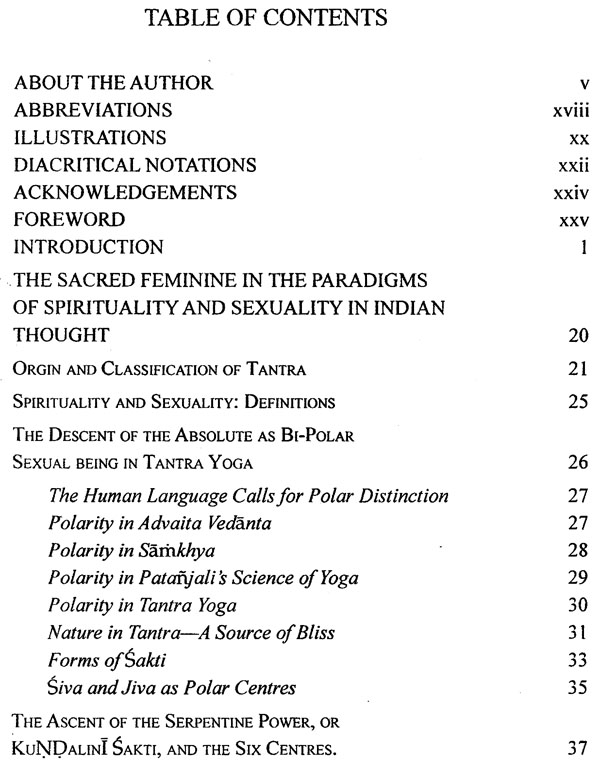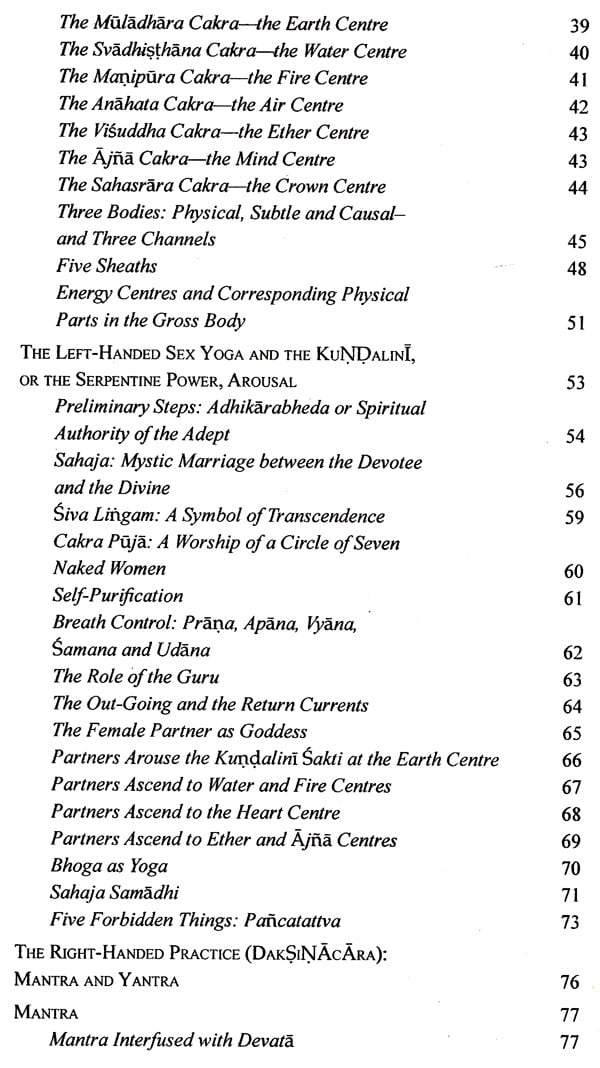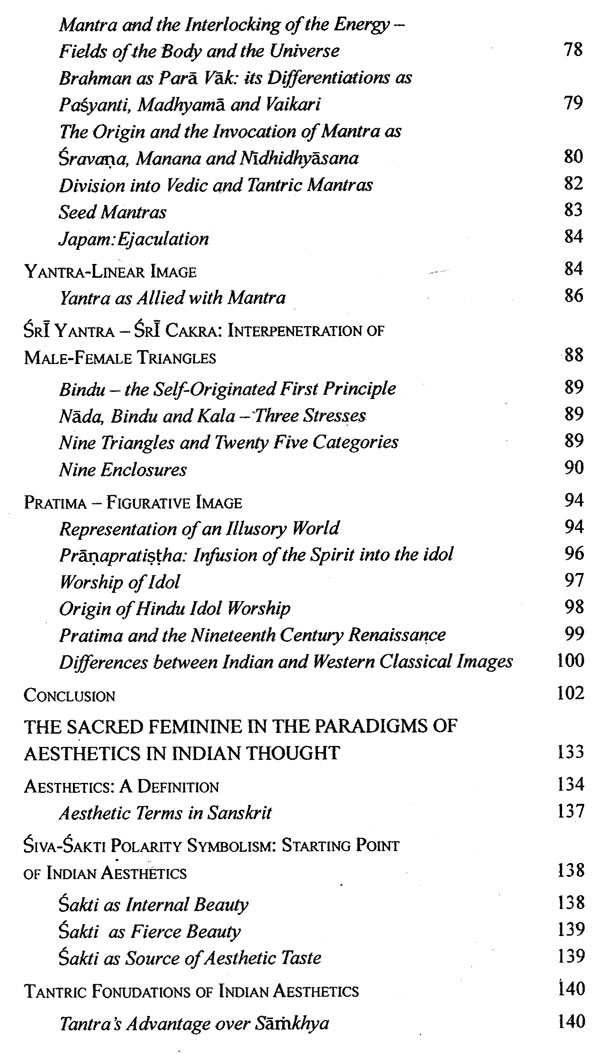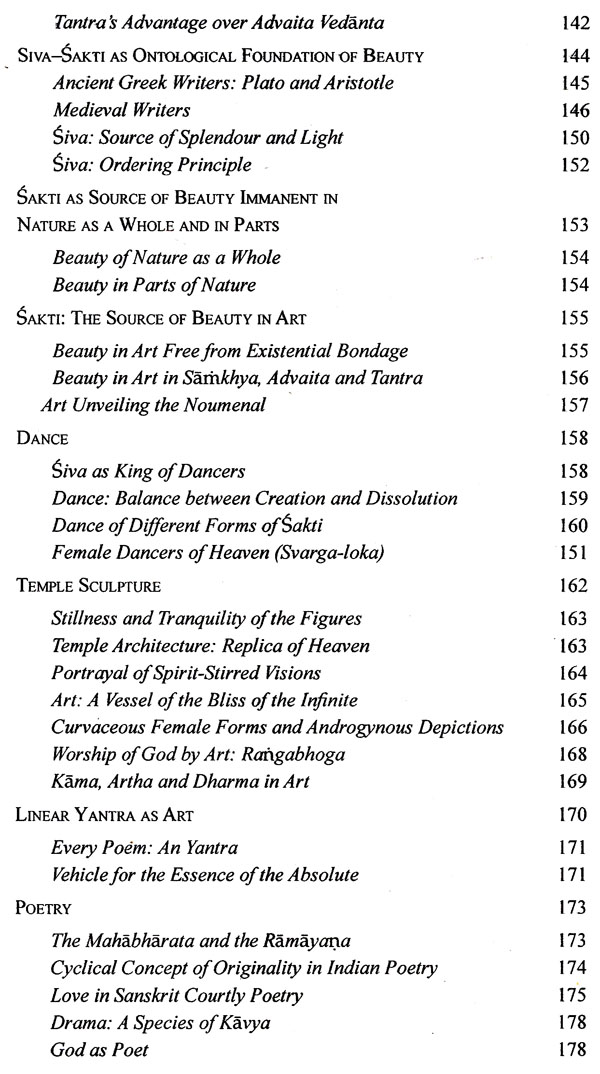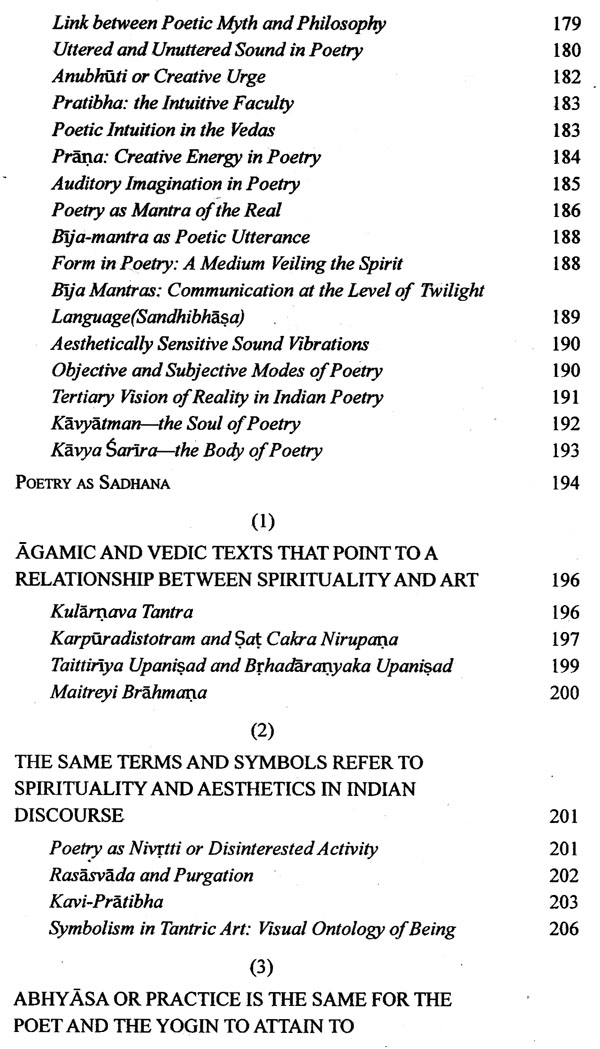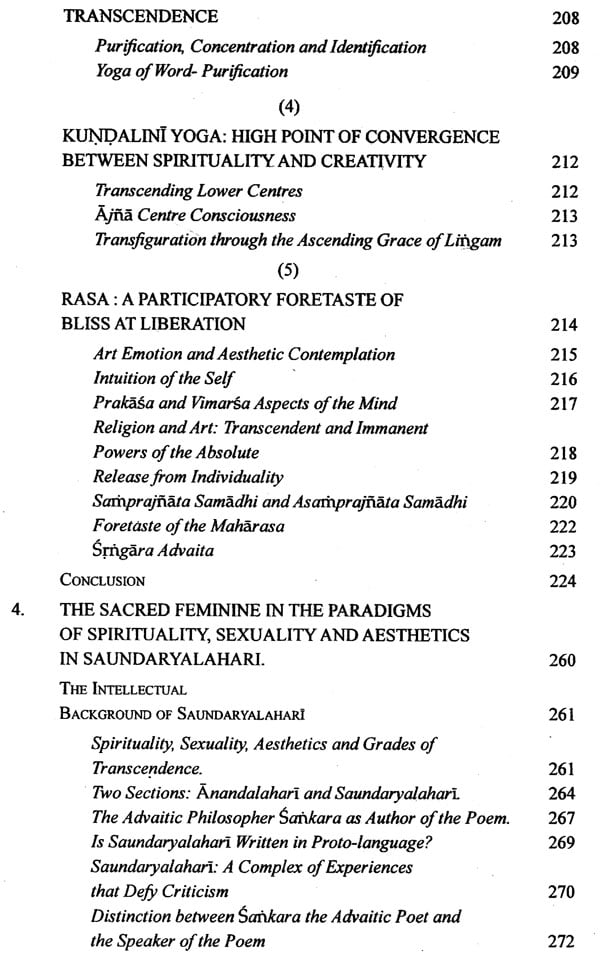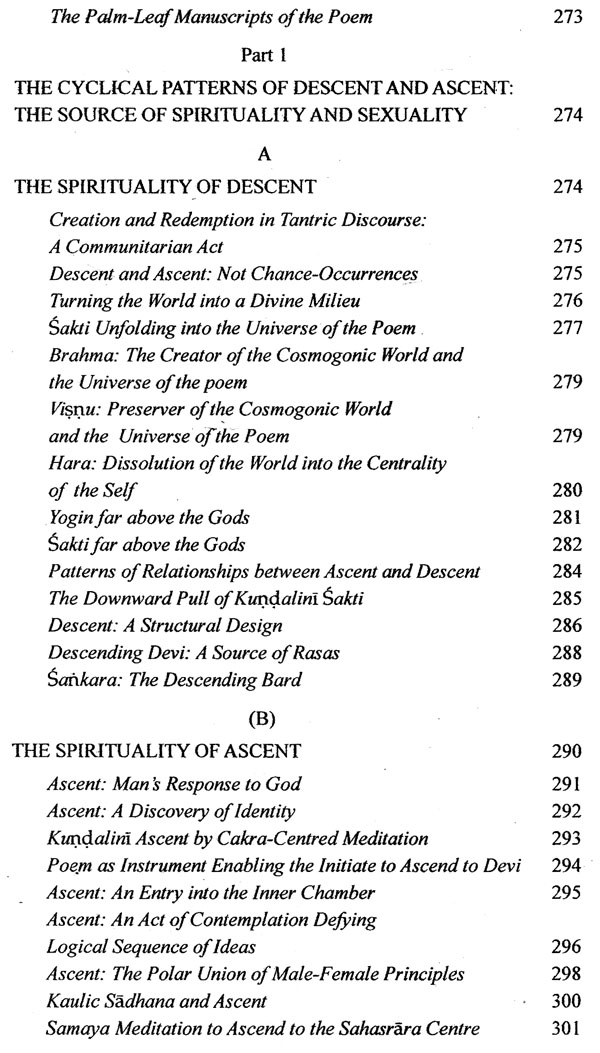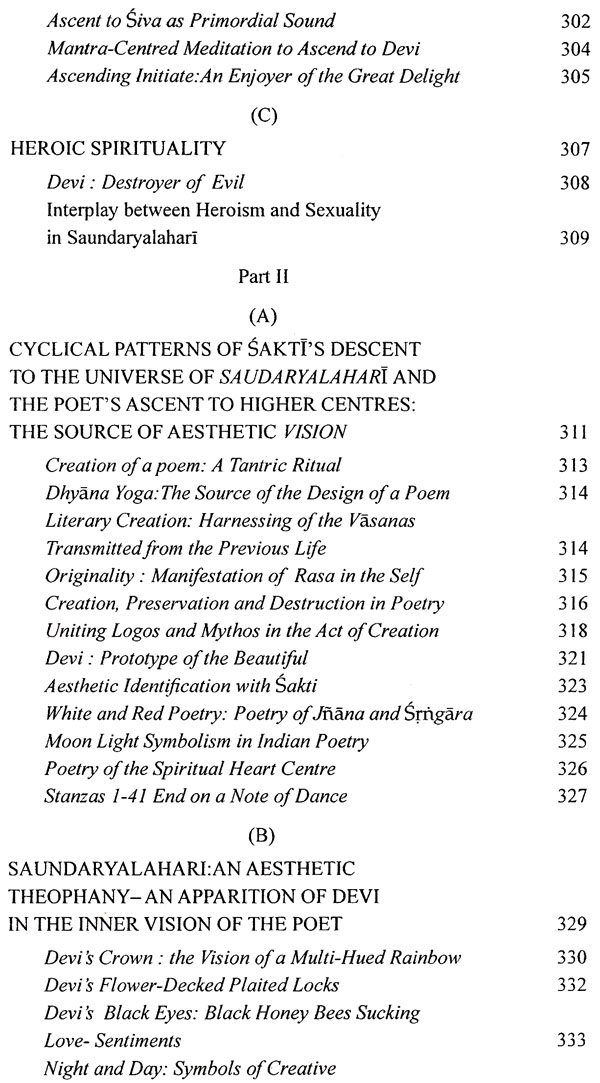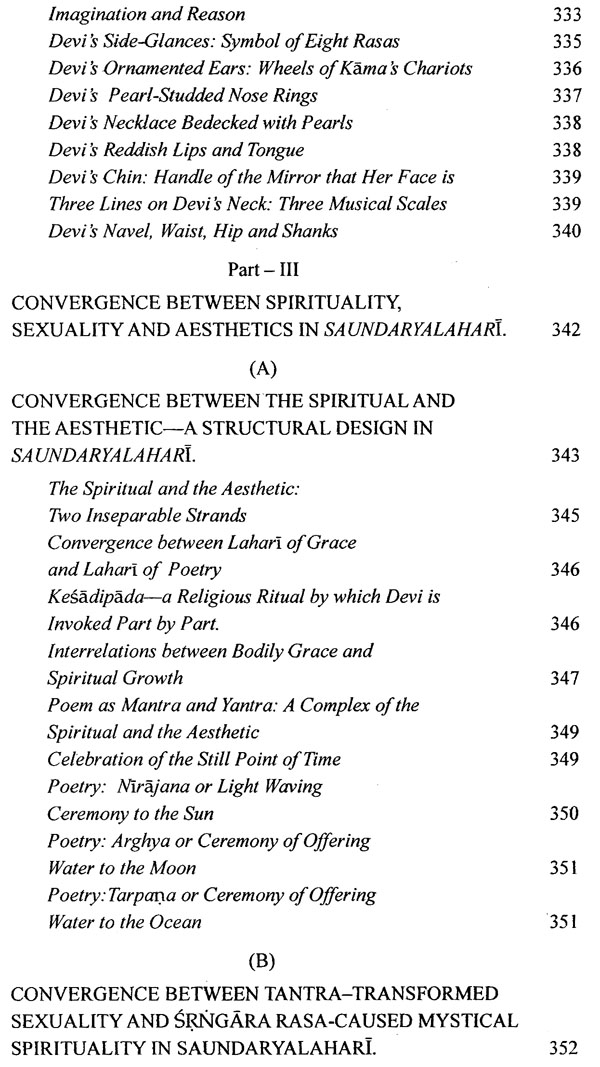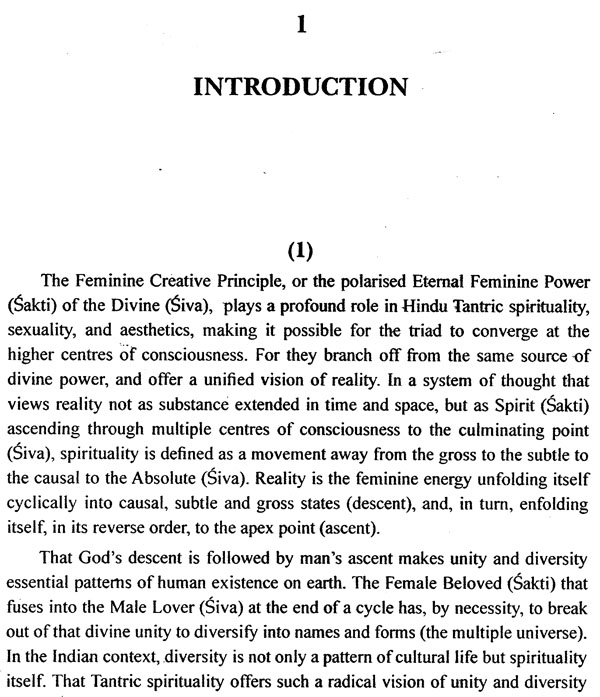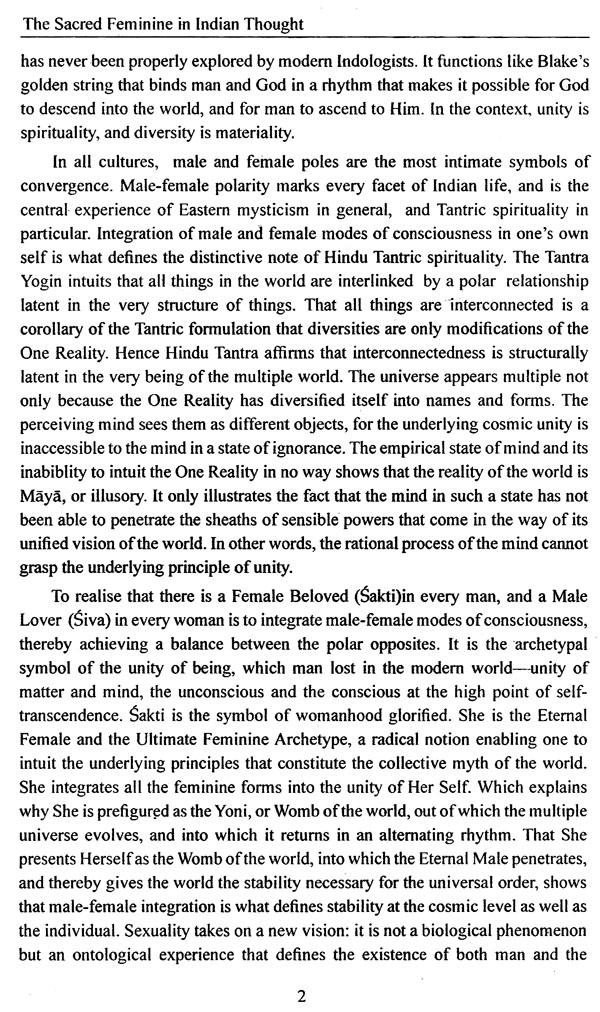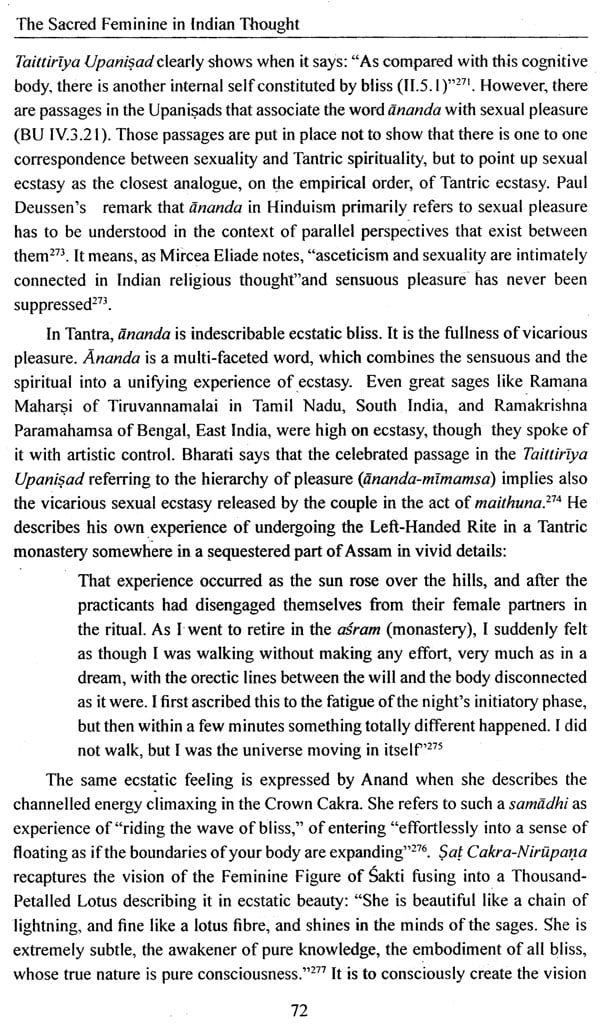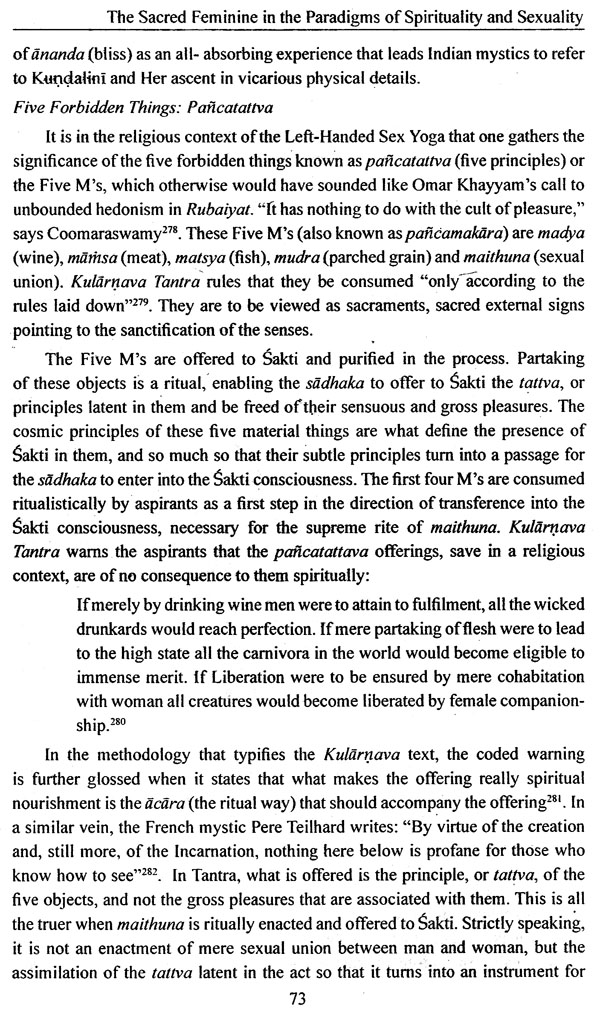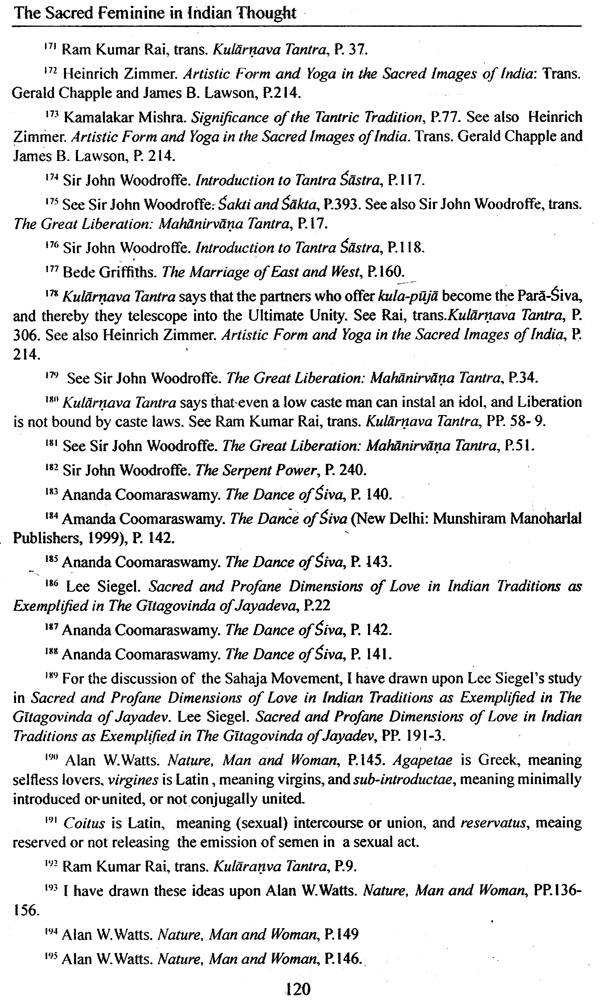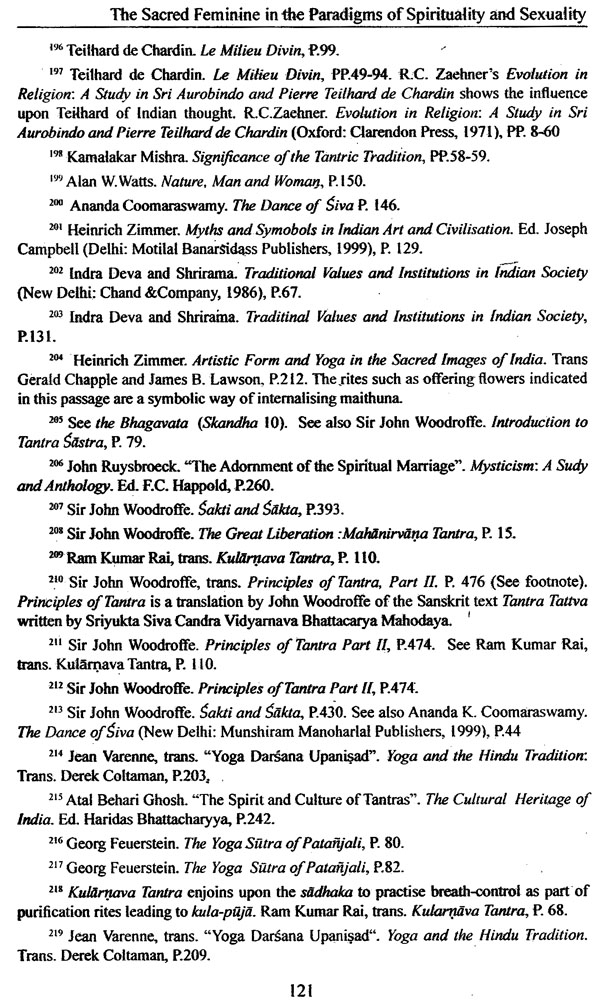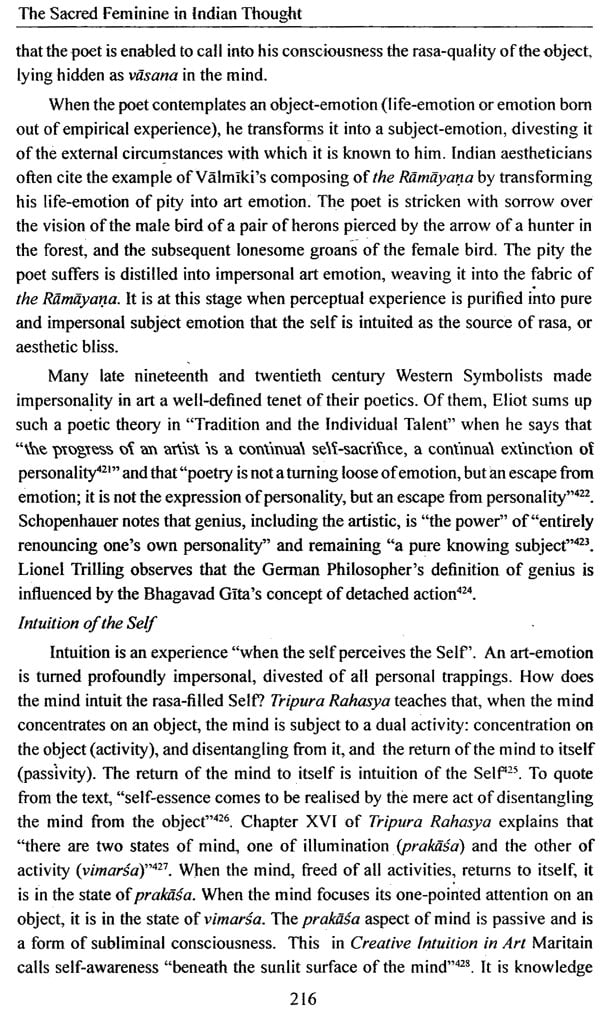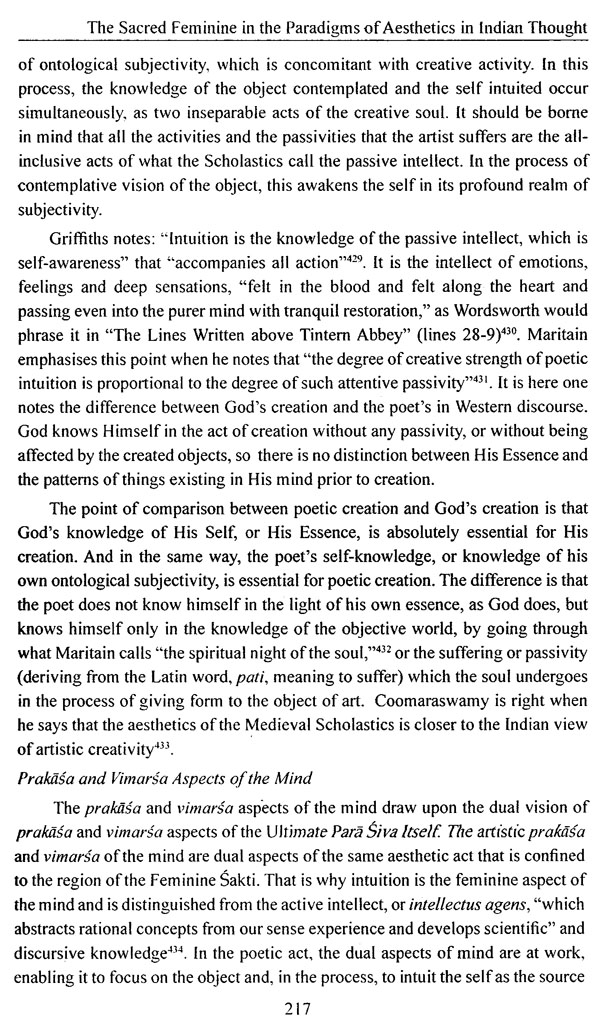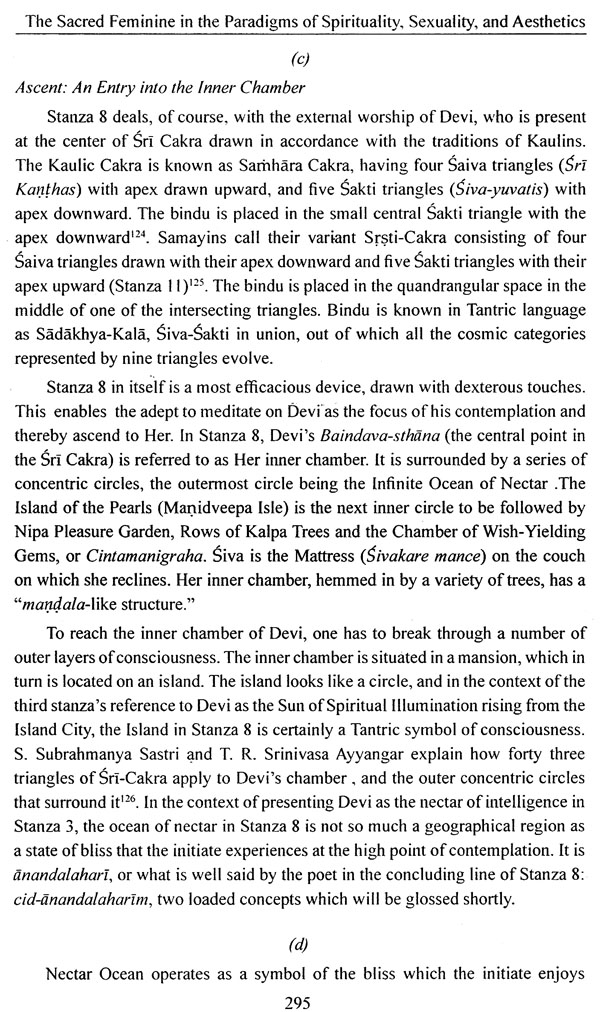
The Sacred Feminine in Indian Thought
Book Specification
| Item Code: | NAV339 |
| Author: | Anniyil Tharakan |
| Publisher: | Cosmo Publications, New Delhi |
| Language: | English |
| Edition: | 2017 |
| ISBN: | 9788130717968 |
| Pages: | 487 |
| Cover: | HARDCOVER |
| Other Details | 10.00 X 7.50 inch |
| Weight | 1.06 kg |
Book Description
As Goethe has rounded off the second half of his Faust with the penetrating remark, nothing has fired the imagination of mankind to yearn for perfection so much as the vision of the Eternal Feminine. The study, in the context of Tantric Metaphysics, focuses on the importance of the feminine or the role of woman in Indian spirituality and aesthetics. Dr. Anniyil Tharakan explores the hidden depths of the feminine to gloss how it operates in Indian thought as a primal force in the ascent of man to spiritual heights and aesthetic vision. The Absolute polarizes into the Male and the Female Creative Principles, the Feminine Principle being the divine energy, descending into multiple names and forms in the universe. It is the descending phase of the Divine that makes the ascending growth of spirituality possible. Hindu spirituality is patterns of rhythm between ascent and descent, man's ascent to the Divine and the Divine's descent to him, between man and woman, so that they become polar to each other and fuse into the identical whole again. Aesthetics is the vision by the ascending self of reality as beauty when it partakes of the patterns of rhythm caused by its ascent and the descending phase of the Divine.
Dr.Anniyil Ninan Tharakan devoted himself to teaching at Mar Ivanios College and St. John's College, both affiliated with the University of Kerala, India. He retired from the latter as its President in 1998. He was a visiting resource person to the UGC Academic Staff College, Trivandrum, and to the University of Kerala to teach M.Phil classes, and has currently been doctoral research guide of the university. He has written for India's national dailies, and international journals published from the United States of America, Ceylon, Chile, France, Italy, and Germany. In 1997, Cross Cultural Publications at Notre Dame, Indiana, the USA, brought out a collection of his poems under the title Quester by the River and Other Poems. The book carried a foreword by Dom Moraes. In 2006, Carmel International Publishing House, Trivandrum, published his Matthew Arnold and the Bhagavad Gita, a study in the light of nineteenth century British interest in the East. In October 2008, a second collection of his poems appeared under the title The Canticle ofthe Beloved, which was brought out by Deepika Book House, Kottayam, Kerala, India. The Canticle of the Beloved won Atma Vidya Award in 2009. In 2008, D.C. Books Private Limited, Kottayam, Kerala, published Dr. Tharakan's well-researched study in Malayalam on Indian Thought in English Poetry (Bharatheeyadarsanam Englishkavithayil). This book won the much-coveted literary award of the Kerala Sahitya Akademi (the Kerala State Literary Academy) in literary criticism for the year 2011. In 2014 Dr. Tharakan was conferred the KCBC Guru Puja Award for his contribution in the field of higher education. Born in the village of Kattanam in the State of Kerala, India, on 20 January 1943, Tharakan was educated in the University of Kerala, and the University of Notre Dame in the United States of America. As a student at school, he studied Aramaic, or West Syriac, and later learnt Latin and Greek. He did a baccalaureate and a licentiate in Philosophy (B.Ph and Ph.L) in 1962-5, and undergraduate and graduate degrees in Theology (B.D and L.D) in 1965-9 at Papal Athenaeum, Poona. At Notre Dame, he was a research scholar, who studied Eastern thought's influence upon nineteeth century English literature. The University conferred on him doctorate in English in April 1987. Following his retirement as faculty of St. John's College in 1998, he took to the study of Sanskrit, and rendered into the English verse the Sanskrit poem Saundaryalahari.
It has been a stimulating experience to have met Dr. Anniyil Tharakan, who characteristically portrays himself as a Hindu by culture, Christian by faith and Syrian by rite, and explored, in turn, his comprehensive probe into a complex subject like the concept of the Feminine in Indian Thought. His deep-rooted theological learning, eastern and western alike, and his extended academic background in other disciplines, make him the most competent person to research on the Feminine in Indian Thought. The exploration into the Feminine is underpinned by Tantric metaphysics, which over the years has fine-tuned the significance of the Feminine and her role in Indian spirituality and aesthetics. Over the years, many scholars of other non-Hindu religions of India like Raimundo Panikkar, noted for his work The Vedic Experience, made original attempts at cross cultural in-depth exploration into Hindu spirituality and culture, thereby making themselves on a par with well-known Orientalists like William Jones, H.T. Colebrooke, Victor Cousin , Wilhelm Von Humboldt and many others. Their writings and their attempts to reach out to Indian thought accelerated the process of the Indian Renaissance that took place in the second half of the nineteenth century and the twentieth.
Like many other scholars in the field of spiritual and cultural studies, Dr. Tharakan has evinced exceptional enthusiasm and conviction which certainly equipped him for a thorough exploration into a complex subject like the concept of the Feminine in Indian thought. To make sure that he is on a firm and authentic ground in his research, he ventured to study the Sanskrit language at the age of seventy. His proficiency in classical Latin, which he learnt at the age of fifteen, certainly provided him with a rich and receptive background to gain ample working knowledge in a classical language like Sanskrit. Moreover, his tireless doctoral research on the original Sanskrit sources like the Bhagavad Gita and their influence on nineteenth century English literature at Notre Dame University kept him in good stead for the present study. The current monograph mirrors the methodology he has acquired in the course of his tenure as an academic in the University of Notre Dame in the USA.
With the exception of Sir John Woodroffe's writings in the early twentieth century, there has been no broad study either in East or West on the Sacred Feminine in Indian thought in the context of Tantric metaphysics. Woodroffe's Sakti and Sakta and The Serpent Power have been extremely popular books, which have inspired American and Continental scholars to think in this line. Nevertheless, such attempts remained on a peripheral level, without delving into the depths of the secret and inspiring world of the Feminine in Hindu discourse. With the dawn of the nineteenth century, the efforts of the West to reach out to the East and its paradigms continued gaining ground, but without sustained and exhaustive progress. The whole intellectual history of the East-West marriage is encapsulated in Dr. Tharakan's study, and as such, his work is a priceless document that dissects the defining principles of the Feminine in Indian culture.
**Contents and Sample Pages**
